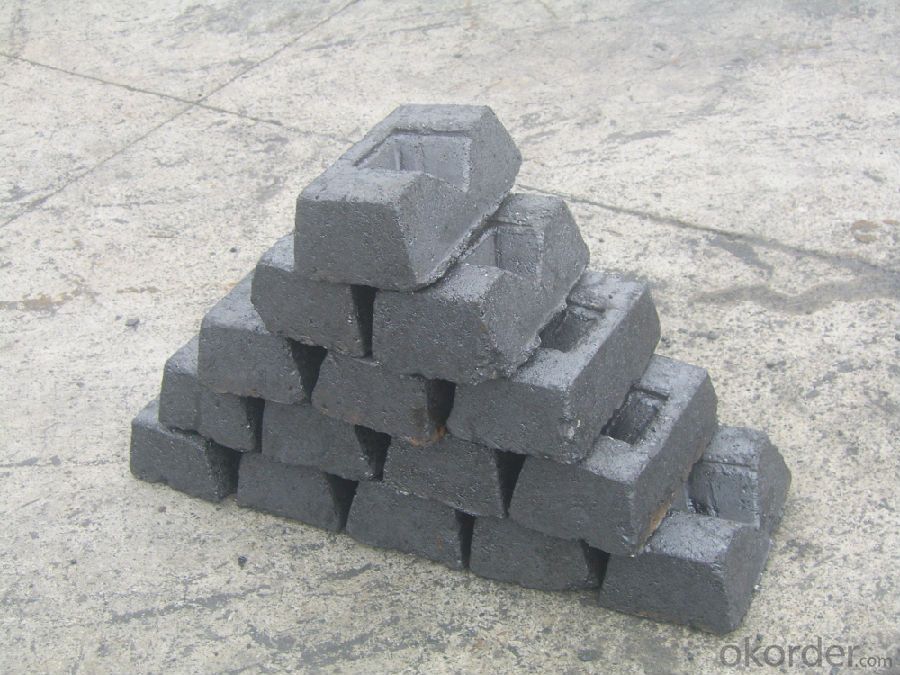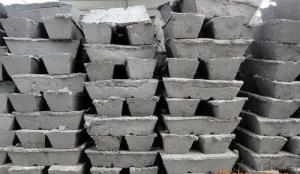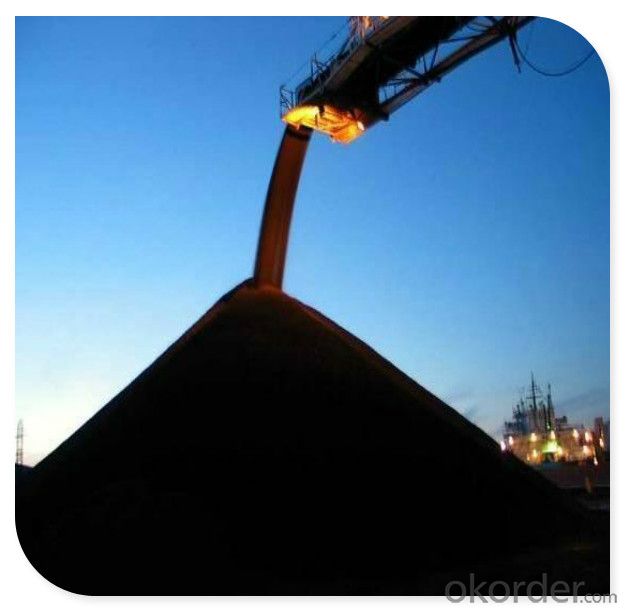Carbon Electrode Paste Block With Low Ash 4% Max
- Loading Port:
- Lianyungang
- Payment Terms:
- TT OR LC
- Min Order Qty:
- 20 m.t.
- Supply Capability:
- 800 m.t./month
OKorder Service Pledge
OKorder Financial Service
You Might Also Like
Carbon Electrode Paste Block With Low Ash 4% Max
Graphite/Carbon Electrode Paste Specification
| PARAMETER UNIT GUARANTEE VALUE | ||||||
| Ash.( % ) | 4.0 max | 5.0 max | 6.0 max | 7.0 max | 9.0 max | 11.0 max |
| V.M (%) | 12.0-15.5 | 12.0-15.5 | 12.0-15.5 | 9.5-13.5 | 11.5-15.5 | 11.5-15.5 |
| Compress Strength. | 18.0 min | 17.0 min | 15.7 min | 19.6 min | 19.6 min | 19.6 min |
| Specific Resistance | 65 max | 68 max | 75 max | 80 max | 90 max | 90 max |
| Bulk Density | 1.38 min | 1.38 min | 1.38 min | 1.38 min | 1.38 min | 1.38 min |
Features
1:carbon eletrode paste
2:for ferroalloy,calcium carbide manufacture
3:HS 3801300000,YB/T5212-1996,ISO9001:2008
Product Description
Carbon Electrode Paste is a self-baking electrode used in submerged arc furnaces for delivering power to the charge mix. Electrode Paste is added to the top of the electrode column in either cylindrical or briquette form. As the paste moves down the electrode column the temperature increase causes the paste to melt and subsequently bake forming a block of electrically conductive carbon. Electrode Paste is essentially a mix of Electrically Calcined Anthracite (ECA) or Calcined Petroleum Coke (CPC) with Coal Tar Pitch.

- Q:How does carbon affect the formation of desertification?
- Carbon does not directly affect the formation of desertification. Desertification is mainly caused by a combination of natural factors such as climate change, prolonged drought, and human activities like deforestation and overgrazing. However, carbon indirectly plays a role in exacerbating desertification through climate change. Carbon dioxide (CO2) is a greenhouse gas that is released into the atmosphere through human activities, primarily the burning of fossil fuels. The increased concentration of CO2 in the atmosphere leads to global warming, which alters climate patterns and increases the frequency and intensity of droughts. Prolonged droughts can cause soil moisture depletion, making the land more susceptible to erosion and degradation, thus contributing to the desertification process. Moreover, carbon indirectly affects desertification through deforestation. Trees and other vegetation play a crucial role in maintaining healthy soil by preventing erosion, retaining moisture, and providing shade. When forests are cleared, the carbon stored in trees is released into the atmosphere, contributing to increased CO2 levels. Additionally, the loss of vegetation cover exposes the soil to erosion by wind and water, accelerating desertification. It is important to note that while carbon indirectly impacts desertification through climate change and deforestation, desertification itself is a complex process influenced by various factors. Addressing desertification requires a comprehensive approach that involves sustainable land management practices, reforestation efforts, water management, and climate change mitigation strategies.
- Q:How much is a ton of carbon fiber? How much difference is made between domestic and imported?
- To 12K carbon fiber, for example, domestic prices between 16~17 million, imports of Dongli carbon fiber prices between 27~29 million.
- Q:What does carbon cloth tonnage mean?
- Carbon cloth tonnage is illegal: mean a square centimeter of sectional area of carbon cloth tension of tonnage. Meaning that the carbon cloth rolled into a solid "rod" if the cross-sectional area of the bar is 1 cm, the maximum tension tonnage it bear -- carbon cloth tonnage.
- Q:What is carbon black dye?
- Derived from carbon black, a fine black powder resulting from the incomplete combustion of hydrocarbon materials, carbon black dye is a highly sought-after dye. It finds extensive usage as a pigment and dye across various industries, such as ink, paint, rubber, plastics, and textiles. Renowned for its intense black hue and exceptional lightfastness, carbon black dye resists fading when exposed to sunlight or other light sources. Moreover, this dye's strong coloring properties enhance the depth and darkness of other colors, rendering them more visually appealing and vibrant. Furthermore, carbon black dye boasts remarkable heat stability, chemical resistance, and electrical conductivity, making it versatile for a wide array of applications.
- Q:How is carbon used in the production of carbon fiber?
- Carbon plays a vital role in the production of carbon fiber. Carbon fiber production involves subjecting a precursor material, typically a polymer like polyacrylonitrile (PAN) or rayon, to a series of heating and chemical treatments. Initially, the precursor material undergoes carbonization, a process where it is heated to a high temperature without oxygen. This carbonization stage includes pyrolysis, which breaks down the molecular structure and eliminates non-carbon elements such as hydrogen, oxygen, and nitrogen. Once carbonization is complete, the resulting material becomes a carbon-rich structure referred to as char. However, it is not yet considered carbon fiber. To convert the char into carbon fibers, further processing steps called stabilization and graphitization are necessary. During stabilization, the char is exposed to heat in the presence of oxygen, resulting in the formation of cross-linked structures. This step enhances the fiber's thermal stability and prevents shrinkage or deformation during subsequent processing. Following stabilization, the material is heated at a higher temperature in an inert atmosphere during graphitization. This process aligns the carbon atoms within the fiber, creating a highly ordered and crystalline structure. Throughout this entire process, carbon serves as the primary constituent of the resulting carbon fiber. Starting from the precursor material containing carbon atoms, the carbonization and graphitization steps remove impurities and rearrange the carbon atoms, producing a durable and lightweight fiber. The resulting carbon fiber possesses exceptional properties, including high strength-to-weight ratio, stiffness, and resistance to heat and chemicals. These attributes make it a valuable material in numerous industries, such as aerospace, automotive, and sporting goods.
- Q:RT~ I remember our teacher said, but I forgot all of a sudden......Ask for advice!
- Well, secondary carbon and oxygen double bonds do not add much. What is involved in high school?:1, in the nickel catalyzed conditions, with H2 addition (also a reduction, but note that in the carboxyl group -COOH carbon oxygen double bond can not be added by the general method plus H)2, aldehyde addition (aldol condensation). The college entrance examination had many times, is simply an aldehyde -CHO under certain conditions and containing active H group reaction R-H (commonly known as alpha H that -H doesn't have to be in the next -CHO H, like -COOH, phenyl can also, but to see more in the next -CHO generation of C- (OH) -R). The H is added to the O, and the alkyl R- is added to the C.For example: CH3-CHO+HCHO==CH3-C (OH) -CHO (called 2- 3-hydroxypropanal)There are some universities, the mechanism involved is more complex, you want to HI me
- Q:How does carbon affect the formation of heatwaves?
- Carbon dioxide, a greenhouse gas, plays a significant role in the formation of heatwaves. When carbon dioxide is released into the atmosphere through human activities such as burning fossil fuels and deforestation, it acts as a blanket, trapping heat from the sun and preventing it from escaping back into space. This phenomenon is known as the greenhouse effect. As carbon dioxide levels continue to rise, the Earth's temperature also increases, leading to more frequent and intense heatwaves. The excess heat trapped in the atmosphere creates a feedback loop, further exacerbating the problem. Heatwaves occur when high-pressure systems stall over a region for an extended period, causing temperatures to soar well above average. Carbon not only influences the intensity of heatwaves but also their duration. The increased greenhouse effect prolongs the time during which heatwaves persist, making them more dangerous and damaging. This prolonged exposure to extreme heat can have severe consequences on human health, leading to heat-related illnesses, increased mortality rates, and reduced productivity. Furthermore, carbon emissions contribute to climate change, which alters weather patterns and leads to more extreme events like heatwaves. Climate models project that heatwaves will become more frequent, longer-lasting, and intense in the future if carbon emissions are not significantly reduced. Addressing the issue of carbon emissions is crucial in mitigating the impacts of heatwaves. Transitioning to cleaner and renewable energy sources, implementing energy efficiency measures, and promoting reforestation efforts are some of the steps that can be taken to reduce carbon dioxide levels. By doing so, we can mitigate the formation of heatwaves and protect both human health and the environment.
- Q:How does carbon affect the formation of permafrost thawing?
- Carbon can have a significant impact on the formation of permafrost thawing. Permafrost is a layer of frozen soil, rock, and organic matter that remains at or below freezing for at least two consecutive years. It acts as a natural carbon sink, storing large amounts of organic carbon from dead plants and animals that have accumulated over thousands of years. When permafrost thaws, this stored carbon starts to decompose, releasing greenhouse gases such as carbon dioxide and methane into the atmosphere. The carbon released from permafrost thawing contributes to the overall increase in greenhouse gas concentrations, exacerbating climate change. Additionally, as permafrost thaws, it becomes more vulnerable to erosion and subsidence, leading to changes in the landscape and the release of even more carbon. This process can create a positive feedback loop, where the released carbon further accelerates permafrost thawing, resulting in more carbon emissions. Furthermore, permafrost thawing can also impact the stability of infrastructure built on frozen ground, such as roads, buildings, and pipelines, leading to significant economic and environmental consequences. In summary, carbon plays a crucial role in the formation and thawing of permafrost. The release of carbon from thawing permafrost contributes to climate change, accelerates the thawing process, and has various environmental and economic impacts. Addressing carbon emissions and finding ways to mitigate permafrost thawing is essential to combatting climate change and preserving the stability of these frozen ecosystems.
- Q:How does carbon impact the stability of savannah ecosystems?
- The stability of savannah ecosystems relies heavily on carbon, which is crucial for all living organisms and involved in various ecological processes. Carbon exists primarily in the form of organic matter, which is vital for the growth and development of plants, the primary producers in these ecosystems. In savannahs, carbon affects stability in multiple ways. Firstly, carbon dioxide (CO2) plays a significant role in regulating the global climate as a key component of the Earth's atmosphere. Savannahs have the ability to sequester and store large amounts of carbon in their vegetation and soils, thereby mitigating climate change by reducing CO2 levels in the atmosphere. Carbon is also essential for plant growth through photosynthesis. Savannah plants, like grasses and scattered trees, utilize carbon dioxide from the air to produce carbohydrates and other organic compounds. This process not only provides plants with energy but also contributes to the overall productivity of the ecosystem. The stability of savannah ecosystems is also dependent on the interaction between plants and animals. Carbon-rich vegetation serves as a food source for herbivores, which in turn support predators. The carbon cycle ensures a continuous flow of energy and nutrients throughout the food web, maintaining ecosystem balance and stability. Moreover, the carbon content in savannah soils affects their fertility and ability to retain moisture. Organic matter derived from decaying plant material improves soil structure, nutrient availability, and water holding capacity. This, in turn, supports vegetation growth and sustains the diverse array of species found in savannah ecosystems. However, human activities such as deforestation, agricultural practices, and the burning of fossil fuels are disrupting the carbon balance in savannahs. Deforestation removes carbon-rich trees and plants, reducing the overall carbon storage capacity of the ecosystem. Additionally, the release of carbon dioxide from burning fossil fuels contributes to the greenhouse effect and climate change, which can disrupt savannah ecosystem stability. In conclusion, carbon plays a critical role in maintaining the stability of savannah ecosystems. It influences climate regulation, supports plant growth, provides energy for the food web, and enhances soil fertility. However, human activities that disrupt the carbon balance in these ecosystems can have detrimental effects on their stability and overall health. Therefore, it is essential to conserve and restore savannah ecosystems to preserve their carbon storage capacity and ensure long-term stability.
- Q:Will long-term use of carbon alloy chopsticks cause cancer?
- Do chopsticks also cause cancer? Experts say, should not use too long, 3 to 6 months that change, pay attention to chopsticks material selection, use and maintenance. Have you noticed how often the chopsticks are changed at home? Recently, a news about the need for regular replacement of chopsticks, attracted the attention of Internet users. According to reports, hidden in the small groove in the chopsticks bacteria, may cause dysentery, gastroenteritis and other diseases, it is recommended that the public, chopsticks should be replaced at regular intervals of 3~6 months. This makes many people surprised, "used so many years chopsticks, do not know!"." Yesterday morning, in the south near Xi'an Renrenle supermarket shopping public Ms. Hao said. Subsequently, a random survey of 20 members of the public, of which 4 people said that in the six months of internal moving or kitchen renovation and replaced chopsticks. While the other 16 citizens, the number of chopsticks used in the home was 1~3 years. Especially for families with old people, chopsticks are updated more slowly. "The old man can't bear to throw it. He can't help it. Every time he comes to the restaurant, the chopsticks are not enough."." Liu said the public. In this regard, yesterday, director of the Xi'an Municipal Hospital of traditional Chinese Medicine Department of Gastroenterology physician Huang Yahui said, if the wood and bamboo chopsticks used for a long time, it is easy to breed bacteria sawdust loose.
1. Manufacturer Overview |
|
|---|---|
| Location | |
| Year Established | |
| Annual Output Value | |
| Main Markets | |
| Company Certifications | |
2. Manufacturer Certificates |
|
|---|---|
| a) Certification Name | |
| Range | |
| Reference | |
| Validity Period | |
3. Manufacturer Capability |
|
|---|---|
| a)Trade Capacity | |
| Nearest Port | |
| Export Percentage | |
| No.of Employees in Trade Department | |
| Language Spoken: | |
| b)Factory Information | |
| Factory Size: | |
| No. of Production Lines | |
| Contract Manufacturing | |
| Product Price Range | |
Send your message to us
Carbon Electrode Paste Block With Low Ash 4% Max
- Loading Port:
- Lianyungang
- Payment Terms:
- TT OR LC
- Min Order Qty:
- 20 m.t.
- Supply Capability:
- 800 m.t./month
OKorder Service Pledge
OKorder Financial Service
Similar products
New products
Hot products
Related keywords































